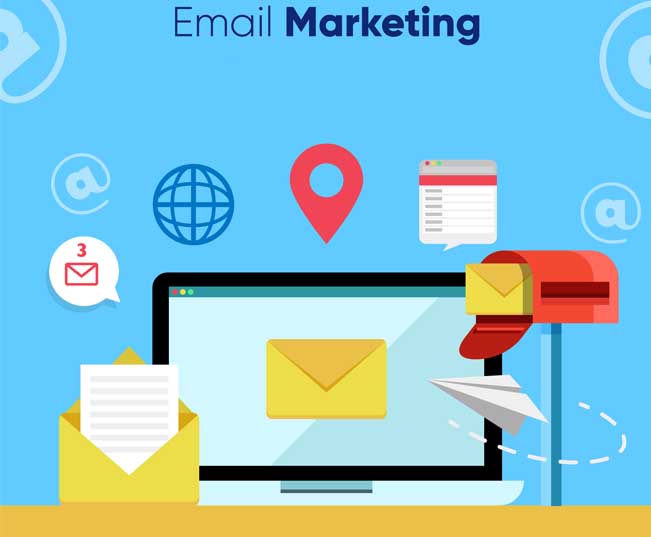
In a world full of social media and instant messaging, email marketing remains one of the most effective tools for engaging your audience, driving sales, and nurturing customer relationships. With an ROI of $42 for every $1 spent, email marketing is a strategy no business should overlook. In this blog, we’ll explore why email marketing is essential, how to build an email list, and strategies to create campaigns that convert.
Why Email Marketing is Crucial for Your Business
- Direct Access to Your Audience: Unlike social media, where algorithms control visibility, emails go straight to your audience’s inbox.
- Personalization: Email allows for personalized messages that can be tailored to individual preferences and behaviors.
- Cost-Effective: Email marketing is one of the most affordable marketing channels, making it a great option for businesses of all sizes.
- High ROI: Email marketing consistently delivers a strong return on investment, especially when done right.
Step 1: Building a High-Quality Email List
The foundation of any successful email marketing strategy is a strong email list. But it’s not just about numbers—it’s about quality. Here’s how to build a list of engaged subscribers:
- Create an Opt-In Offer People won’t give you their email address without a reason. Offer something valuable in return, such as:
- A free eBook
- A discount or coupon code
- Exclusive access to a webinar
- Free templates or resources
- Use Sign-Up Forms Place sign-up forms prominently on your website, blog, and social media channels. Make sure the form is easy to fill out and clearly states the value of signing up.
- Leverage Pop-Ups and Exit-Intent Forms Pop-ups can be used strategically to capture leads. Exit-intent pop-ups trigger when users are about to leave your site, giving you one last chance to collect their information.
- Collect Emails Through Social Media Use your social media platforms to promote your email newsletter. Encourage followers to subscribe by offering exclusive content or deals available only through email.
Step 2: Creating Engaging Email Content
Once you have a list, the next step is to deliver content that keeps your audience engaged. Here are key types of emails that can drive engagement and conversions:
- Welcome Emails The first email you send to new subscribers should set the tone for your relationship. Thank them for subscribing and explain what they can expect from your emails.
- Newsletter A regular email newsletter keeps your audience informed about your latest blog posts, product updates, industry news, and more. Ensure that each edition provides value, not just promotional content.
- Promotional Emails Whether you’re running a special sale or launching a new product, promotional emails are an effective way to drive traffic and conversions. Make sure your offer is clear, compelling, and time-sensitive to create urgency.
- Personalized Emails Use data to send personalized emails based on your subscribers’ behavior, preferences, or past purchases. For example, send product recommendations or special birthday offers.
- Re-Engagement Emails Sometimes, subscribers become inactive. Send a re-engagement campaign to win them back. You can offer special discounts or remind them why they signed up in the first place.
Step 3: Best Practices for Effective Email Campaigns
Follow these email marketing best practices to ensure your campaigns are effective:
- Segment Your List Instead of sending the same email to your entire list, segment it based on different factors like purchase history, interests, or engagement level. This allows you to send more targeted and relevant messages.
- Craft Compelling Subject Lines The subject line is the first thing your subscribers see. Make it enticing, concise, and relevant. A/B testing your subject lines can also help you find out what resonates best with your audience.
- Optimize for Mobile With a majority of users checking their email on mobile devices, it’s crucial that your emails are mobile-friendly. Use responsive email templates and keep your design simple and readable.
- Use Clear Call-to-Actions (CTAs) Every email should have a clear purpose. Whether you want your subscribers to visit your website, make a purchase, or read your latest blog, include a strong, visually distinct CTA button.
- Test and Optimize Continuously improve your email campaigns by testing different elements. A/B test your subject lines, email design, send times, and copy. Use the data to refine your strategy over time.
Step 4: Analyze Your Email Marketing Performance
To know whether your email marketing efforts are working, you need to track key metrics:
- Open Rate: The percentage of subscribers who open your email. A low open rate may indicate weak subject lines or a disengaged list.
- Click-Through Rate (CTR): The percentage of subscribers who clicked a link in your email. A low CTR may mean your content or CTA isn’t compelling enough.
- Conversion Rate: The percentage of subscribers who take the desired action (e.g., make a purchase or fill out a form).
- Bounce Rate: The percentage of emails that couldn’t be delivered. A high bounce rate may indicate a need to clean up your email list.
- Unsubscribe Rate: The percentage of subscribers who opt out of your emails. Keep an eye on this to ensure your content remains relevant.
Conclusion:
Email marketing is a powerful way to build relationships, nurture leads, and drive conversions. By following the steps above—building a quality email list, creating engaging content, and implementing best practices—you can unlock the full potential of email marketing for your business.
Want to kickstart your email marketing strategy? Contact Webmarkitors today, and let us help you build campaigns that get results!

